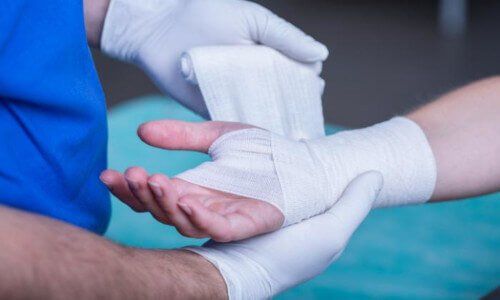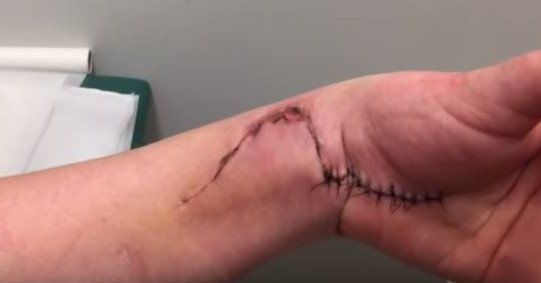Here's What to Expect From Carpal Tunnel Surgery
From Dr. Z - Carpal tunnel syndrome specialist
What to Expect From Carpal Tunnel Surgery
Here's what to expect from carpal surgery. Knowing everything that happens will minimize your anxiety going into the operation. You'll learn how much pain there will be, if your hand will be normal again, and how much rehab time is needed.
Also included are issues you may not have thought about like infections and complications. It's important to learn all you can now to avoid surprises when the bandages go on your hand.
- FIND OUT: do you have carpal tunnel? No strings attached self-test.
General expectations from carpal tunnel surgery
Having carpal tunnel surgery is no small matter. It should be your last resort to treat carpal tunnel syndrome. That's after you tried everything else without success. The pain, numbness, tingling or weakness just won't go away.
During carpal tunnel surgery, the doctor’s aim is to cut the transverse carpal ligament in the lower palm. This structure holds the wrist bones together in a bundle. By cutting it, the wrist area snaps apart. That relieves pressure on the median nerve in between the bones.
The process sounds simple enough. But it’s a major operative procedure that requires skill and patience. Any mishap and you could lose a good proportion of your hand or finger function.
You can have one of two basic types of surgery to cut that ligament. Your doctor will decide on which procedure to use, as outlined below:
- Open carpal tunnel release surgery - This procedure requires the surgeon make a 2-3 inch long incision in your palm. Then the surgeon can see the ligament and other structures (nerves and blood vessels) in the area. The long incision affords a wide field of view to help avoid accidentally lacerating a vital structure. But this operation also causes more trauma, post-surgical pain, and requires longer recovery time.
- Endoscopic carpal tunnel release surgery - This procedure requires the surgeon make only one or two small holes in your palm. Then an endoscope is passed through the hole(s) to let the surgeon cut the ligament. Obviously, there's a smaller field of view. That increases the possibility of accidentally cutting a vital structure. But trauma and pain are reduced, and recovery time is shorter.
Your carpal tunnel doctor probably went into detail with you about how it works. Unfortunately, most doctors gloss over the part about “after surgery” because it's a "painful" discussion. This is one of the main reasons many patients don’t know what to expect from tunnel carpal surgery.
However, there are two basic results you will most likely see after surgery. First, there will be post-surgical pain for a few days. Second, there will be some degree of hand function loss. These expectations are outlined below.
Expect post-surgical pain
Nobody likes pain. That’s why it’s part of every question we hear from patients. So knowing how much pain to expect from carpal tunnel surgery will let you better prepare for it.
So to be clear, there will be pain after the surgery. There's no glossing over that fact.
However, you won’t feel any pain during the actual operation. You’ll either be asleep or have a local numbing agent in your arm or wrist. It’s when these medicines wear off, after surgery, that pain makes it's appearance.
Even in the recovery room you will not feel much pain at all. The pain injection you got while asleep or the local shot in your hand are still working.
However, when you get home a few hours later, expect the pain to overflow like lava. What's it like? Patients describe it as a constant, pounding type of pain.
But your doctor will have prescribed pain pills to take on a regular basis. They’re just for this kind of pain. Make sure to fill these prescriptions before you get home! The last thing you want is to wait for the prescription is filled while you're climbing a seemingly endless staircase of pain.
You’ll also need the pain pills to help kill the pain while you sleep. Keeping your hand elevated while sleeping minimizes pain substantially.
Expect to have this constant pain for the next 3-4 days. By the end of the week, you’ll need the pain pills only occasionally. Usually over-the-counter pain medicines like Advil or Tylenol will suffice by then. And usually, you'll need them mainly to sleep.
Moving around the house too much will cause the pain to increase. So take it easy for several days. Also, when seated try to rest with your hand elevated to minimize blood pooling and pain.
Expect reduced hand function
The idea of having hand surgery is to eliminate the most common symptoms of carpal tunnel syndrome. And surgery does that pretty quickly in about half of patients.
However, the other half take much longer to see good results. It may take several months.
Still others never see much reduction in symptoms, if at all. And an unfortunate few see worse symptoms and lasting pain. These are abnormal outcomes, and not what to expect from carpal tunnel surgery when things go right.
Below I’ve outlined what happens when you have GOOD versus POOR results from carpal tunnel surgery.
Good surgical results
When everything goes right, the results you can expect from carpal tunnel surgery are nothing short of miraculous. Specifically, you can expect your hand to slowly return to normal. It usually takes 3-6 months to start seeing good results and where your hand is relatively normal again. That’s assuming you did a good job with hand therapy and rehab. Most people can get back to work within that time period.
Full hand strength usually returns by about 1 year. Again, that’s assuming you had good therapy. The best results are in patients who put a lot of time into rehab and strength exercises. Such regular hand therapy is the key to good recovery.
Poor surgical results
There are a fair number of patients who have poor results from surgery. Actually, that comes either from complications or from not doing enough therapy. A smaller number of those patients suffer a failed surgery. Failure is usually due to:
- Symptoms not resolving
- Persistent pain
- Significant hand weakness
Complications of carpal tunnel surgery are relatively rare (under 2% overall). They include infection, nerve injury, excessive bleeding and hand function that's less than before surgery.
However, the majority of poor results often come from inadequate hand therapy after surgery. In short, the patients didn’t know what to expect from carpal tunnel surgery, and nobody discussed therapy and rehab. They were not told that time and energy put into hand rehabilitation is crucial.
Strengthening the hand only comes with a lot of work and effort during rehab. If this isn't done, patients end up with weak grip strength. Many have reduced dexterity and range of motion.
Several studies have measured patient satisfaction after surgery. In fact, this is the best way to tell if a surgery was "successful.” That’s because it takes into account how a person’s life is affected. The results are both surprising and distressing. They found that only 50% of carpal tunnel surgery patients were satisfied 2 years later.
It’s for that reason the National Institutes of Health and American Academy of Orthopedic Surgeons published a recommendation. They advise patients to try all available non-surgical remedies first. In other words, surgery should be the last option to relieve carpal tunnel symptoms.
Summary
What to expect from carpal tunnel surgery depends on several factors. For instance, whether you’re having endoscopic or open release surgery makes a big difference in your pain and recovery time. If there are any complications like infection, scarring or bleeding, your hand function may suffer. Finally, your overall health and ability to heal should be considered as well. All of these issues should be discussed with your doctor. Your doctor should also advise you of all non-surgical options available. In most instances, patients don't require hand surgery to eliminate carpal tunnel symptoms because non-surgical therapies work quite well.








